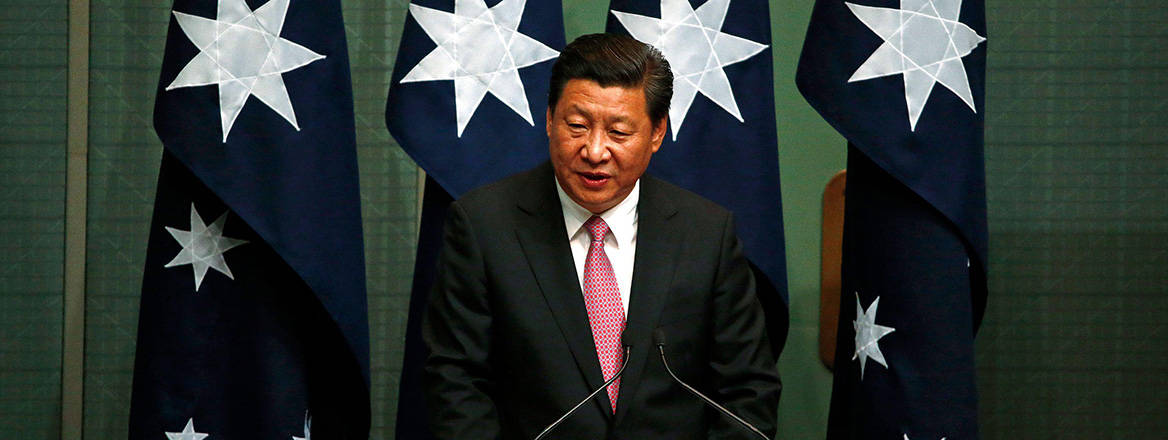Australia’s Answer to China’s Coercive Challenge
Australia’s ability to resist China’s economic coercion may serve as an example to other countries targeted by similar measures.
Economic coercion is as old as statecraft itself. The threat of withdrawing, or actual withdrawal of, customary economic relations has been used for millennia to force other states to change their policies.
Having been used for decades by the US against countries such as Cuba and Iran, China has now also embraced this weapon of war by other means.
China’s latest target is Australia, which joins a long list of victims internationally, including Norway, Japan, South Korea, Canada and Taiwan.
Since May 2020, Australia has been subjected to a sustained and severe campaign of economic coercion. But so far, it remains unfazed and uncowed.
Australia has responded with resilience and determination, despite points of acute economic pain.
Australia–China relations have been in a downward spiral in recent years on a wide range of diplomatic, economic and strategic fronts. Specific flashpoints have included Canberra’s criticisms of Beijing’s human rights abuses, Australian support for international law in the South China Sea, and Australian scrutiny of Chinese investments, among a wide range of other contentious disagreements.
Against this backdrop of steadily souring ties, it was the Australian government’s call in April 2020 for an inquiry into the origins of the coronavirus pandemic that precipitated China’s current campaign of economic coercion, which commenced a month later in May 2020.
Using a range of tools such as tariffs, duties, technical regulatory measures and informal restrictions, at least nine Australian goods exports from beef to barley and cotton to coal have been hit.
A further four Australian exports have either been threatened with trade restrictions or subjected to unconfirmed and piecemeal restrictions. These mooted targets include Australia’s lucrative education industry, which is the country’s fourth largest export and its largest services export by a wide margin.
Notwithstanding the long list of targeted exports, the Australian economy seemed to shrug off China’s coercion at the macro level in 2020. From a record high of A$149 billion worth of goods exports to China in 2019, the value of these exports only declined by roughly 2% to A$146 billion in 2020.
Yet not only was the headline figure of the overall value of goods exports to China in 2020 inflated by the dramatic spike in iron ore prices, but this macro number belies the true scale of the costs and disruption associated with China’s economic coercion.
China’s trade restrictions have targeted large industries such as coal, beef, wine, cotton, and copper ore and concentrates, each of which had exports to China that were worth more than A$1 billion in 2019.
In some industries, China’s trade restrictions have seen a total or near-total halt in imports from Australia. For example, the latest monthly trade data shows that the value of Australian exports of barley, coal, and copper ores and concentrates to China has been slashed to zero in the first few months of 2021. Meanwhile, the value of exports of wine, crustaceans, timber, cotton, sugar and beef dropped by as much as 78% in 2020.
Even when exporters of broadly fungible commodities, such as coal, barley, and copper ores and concentrates, have been able to find alternative export markets, they have had to bear the added costs of rerouting exports and contend with price pressures associated with being blocked from the large and lucrative Chinese market.
Meanwhile, select exporters geared towards the Chinese market, notably particular Australian wines and rock lobsters, have either been unable to find alternative markets for their products or have been forced to sell on the domestic Australian or other international markets at massively discounted prices.
Estimates of the overall costs to the Australian economy vary and are challenging to calculate given the counterfactuals of what would have occurred in the absence of China’s economic coercion. But credible assessments are in the range of A$7 billion to A$10 billion as of early 2021.
As well as export dislocation and short-term costs, China’s trade restrictions may cause long-term and significant economic pain. One recent Australian government study found that the costs of China’s anti-dumping duties on Australian wine alone would reach A$2.4 billion over the five-year period to 2025.
Given these current and future costs, how has the Australian government responded to China’s economic coercion?
Notably, Canberra has not compromised on any of the key points of contention that prompted Beijing to launch its targeted campaign of trade restrictions.
Some past victims of China’s economic coercion, such as Norway, South Korea and Mongolia, persuaded Beijing to end its economic pressure campaigns by making diplomatic or strategic concessions.
By contrast, Australia has held firm on the key policies that originally elicited China’s ire. From criticism of systematic human rights abuses against Uyghurs and other minorities to public opposition to China’s legally untenable maritime claims in the South China Sea, Canberra shows no sign of caving to coercive pressure.
This determination has been made easier by the relatively successful export redirection that has already occurred. Just as China has been able to find alternative suppliers, so too have most Australian exporters been able to find alternative markets.
Take the case of Australia’s previously lucrative wine exports to China. Although the value of Australia’s total wine exports dipped deeply after exports to China collapsed with the November/December 2020 introduction of anti-dumping and countervailing duties, the value of exports to the rest of the world has steadily climbed since January 2021, despite exports to China flatlining.
It remains to be seen whether these rising exports to alternative markets will fully offset the loss of the Chinese market. But the early data suggests that a significant amount of export redirection has already occurred since China shut Australian wines out of its market.
This story of a redirection of targeted Australian exports to alternative markets has been replicated in other industries.
Despite Australian exports of barley, coal, and copper ores and concentrates to China crashing to zero, exports of these commodities to other countries have risen steadily. For example, exports of coal to the rest of the world were approximately 43% higher in the last three months of available trade data than they were in the three months prior to China’s trade restrictions against Australian coal.
Australian government policies are likely to add to the fruits of this export redirection. Canberra is already working on a range of trade access and diversification measures, including Australia’s recently agreed free trade agreement (FTA) with the UK and its ongoing efforts to negotiate FTAs with major global economies such as India and the EU.
Added to these longstanding efforts to gain market access elsewhere, newer measures such as the Australian government’s Agri-Business Expansion Initiative provide financial and other support to Australian businesses hit by China’s trade restrictions.
Although none of these trade diversification measures are likely to fully offset the loss of the large and lucrative Chinese market, cumulatively and over the longer term they will mitigate the impact of China’s economic coercion and increase the resilience of Australian exporters.
China has the economic clout and willpower to pursue punishing campaigns of economic coercion against countries that defy its will. But the Australian experience suggests that the reality of China’s economic coercion may not be as bad as the ominous threat would suggest.
So, just as other victims of China’s economic coercion may draw strength from Australia’s resistance, the Australian experience provides a valuable lesson for Beijing.
The Chinese government would be well advised to use economic coercion sparingly, for its threatening power will be steadily diminished as countries such as Australia are subjected to its sting yet remain resolute and resilient.
As the French philosopher Jean-Jacques Rousseau wrote of life’s misfortunes, countries may increasingly say of China’s economic coercion: ‘As soon as [it] happen[s], [it] lose[s] all the terrors lent to [it] by imagination and appear[s] in [its] true size’.
That is, large enough to cause real pain for select exporters and the communities that they sustain – but by no means so large that it causes a country to capitulate.
The views expressed in this Commentary are the author’s, and do not represent those of RUSI or any other institution.
Have an idea for a Commentary you’d like to write for us? Send a short pitch to commentaries@rusi.org and we’ll get back to you if it fits into our research interests. Full guidelines for contributors can be found here.


